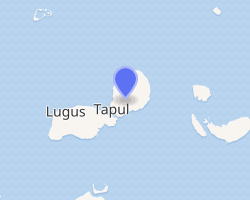Tapul
Tapul, officially the Municipality of Tapul, is a 5th class municipality in the province of Sulu, Philippines. According to the 2015 census, it has a population of 18,197 people.[3]
Tapul | |
|---|---|
| Municipality of Tapul | |
 Map of Sulu with Tapul highlighted | |
OpenStreetMap 
| |
.svg.png) Tapul Location within the Philippines | |
| Coordinates: 5°43′00″N 120°54′00″E | |
| Country | |
| Region | Bangsamoro Autonomous Region in Muslim Mindanao (BARMM) |
| Province | Sulu |
| District | 2nd District |
| Barangays | 15 (see Barangays) |
| Government | |
| • Type | Sangguniang Bayan |
| • Mayor | Nasser T. Daud Jr. |
| • Vice Mayor | Nasser S. Daud |
| • Congressman | Munir M. Arbison |
| • Electorate | 7,562 voters (2019) |
| Area | |
| • Total | 89.17 km2 (34.43 sq mi) |
| Population (2015 census)[3] | |
| • Total | 18,197 |
| • Density | 200/km2 (530/sq mi) |
| • Households | 3,123 |
| Economy | |
| • Income class | 5th municipal income class |
| • Poverty incidence | 48.58% (2015)[4] |
| • Revenue (₱) | 56,550,816.00 (2016) |
| Time zone | UTC+8 (PST) |
| ZIP code | 7410 |
| PSGC | |
| IDD : area code | +63 (0)68 |
| Climate type | tropical climate |
| Native languages | Tausug Tagalog |
| Website | www |
Barangays
Tapul is politically subdivided into 15 barangays.
- Alu-Kabingaan
- Banting
- Hawan
- Kalang (Poblacion)
- Kamaunggi
- Kanaway
- Kanmangon
- Kaumpang
- Pagatpat
- Pangdan
- Puok
- Sayli
- Sumambat
- Tangkapaan
- Tulakan
Climate
| Climate data for Tapul, Sulu | |||||||||||||
|---|---|---|---|---|---|---|---|---|---|---|---|---|---|
| Month | Jan | Feb | Mar | Apr | May | Jun | Jul | Aug | Sep | Oct | Nov | Dec | Year |
| Average high °C (°F) | 27 (81) |
27 (81) |
28 (82) |
28 (82) |
29 (84) |
29 (84) |
28 (82) |
28 (82) |
28 (82) |
28 (82) |
28 (82) |
28 (82) |
28 (82) |
| Average low °C (°F) | 27 (81) |
27 (81) |
27 (81) |
27 (81) |
28 (82) |
28 (82) |
28 (82) |
28 (82) |
28 (82) |
28 (82) |
28 (82) |
27 (81) |
28 (82) |
| Average precipitation mm (inches) | 184 (7.2) |
143 (5.6) |
144 (5.7) |
136 (5.4) |
240 (9.4) |
301 (11.9) |
272 (10.7) |
253 (10.0) |
183 (7.2) |
265 (10.4) |
246 (9.7) |
208 (8.2) |
2,575 (101.4) |
| Average rainy days | 18.6 | 15.8 | 16.9 | 15.7 | 23.3 | 24.2 | 24.6 | 23.2 | 20.5 | 23.0 | 22.2 | 20.4 | 248.4 |
| Source: Meteoblue[5] | |||||||||||||
Demographics
| Year | Pop. | ±% p.a. |
|---|---|---|
| 1903 | 7,440 | — |
| 1918 | 7,358 | −0.07% |
| 1939 | 18,496 | +4.49% |
| 1948 | 16,601 | −1.19% |
| 1960 | 18,577 | +0.94% |
| 1970 | 20,694 | +1.08% |
| 1975 | 28,340 | +6.51% |
| 1980 | 23,472 | −3.70% |
| 1990 | 10,111 | −8.08% |
| 1995 | 12,392 | +3.89% |
| 2000 | 14,881 | +4.00% |
| 2007 | 17,430 | +2.20% |
| 2010 | 16,370 | −2.26% |
| 2015 | 18,197 | +2.03% |
| Source: Philippine Statistics Authority[3][6][7] | ||
gollark: If you program the thing to optimise some utility function - and didn't make a mistake - it won't decide to stop optimising for that.
gollark: What?
gollark: Troubling.
gollark: Instead of a top down design.
gollark: You'd probably just have to emulate all the low level human bits to make things work right.
References
- "Municipality". Quezon City, Philippines: Department of the Interior and Local Government. Retrieved 31 May 2013.
- "Province: Sulu". PSGC Interactive. Quezon City, Philippines: Philippine Statistics Authority. Retrieved 12 November 2016.
- Census of Population (2015). "ARMM – Autonomous Region in Muslim Mindanao". Total Population by Province, City, Municipality and Barangay. PSA. Retrieved 20 June 2016.
- "PSA releases the 2015 Municipal and City Level Poverty Estimates". Quezon City, Philippines. Retrieved 12 October 2019.
- "Tapul, Sulu : Average Temperatures and Rainfall". Meteoblue. Retrieved 31 January 2019.
- Census of Population and Housing (2010). "ARMM – Autonomous Region in Muslim Mindanao". Total Population by Province, City, Municipality and Barangay. NSO. Retrieved 29 June 2016.
- Censuses of Population (1903–2007). "ARMM – Autonomous Region in Muslim Mindanao". Table 1. Population Enumerated in Various Censuses by Province/Highly Urbanized City: 1903 to 2007. NSO.
External links
- Tapul Profile at PhilAtlas.com
- Philippine Standard Geographic Code
- Philippine Census Information
- Local Governance Performance Management System
This article is issued from Wikipedia. The text is licensed under Creative Commons - Attribution - Sharealike. Additional terms may apply for the media files.